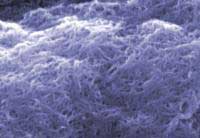Apr 16 2008
The National Institute of Standards and Technology (NIST), in collaboration with the National Aeronautics and Space Administration (NASA), has published detailed guidelines for making essential measurements on samples of single-walled carbon nanotubes (SWCNTs). The new guide constitutes the current “best practices” for characterizing one of the most promising and heavily studied of the new generation of nanoscale materials.
 Scanning electron microscope image of "cleaned" carbon nanotubes at NIST (color added for clarity.)
Scanning electron microscope image of "cleaned" carbon nanotubes at NIST (color added for clarity.)
The nanotubes are essentially cylinders of carbon atoms with a wall only one atom thick and a diameter of a couple of nanometers—but lengths up to several million times their diameter. (Think of a soup can about 100 kilometers tall.) Because of their unique electronic, thermal, optical and mechanical properties they are being studied for a wide—and expanding—range of applications, including ultrastrong fibers for nanocomposite materials, circuit elements in molecular electronics, hydrogen storage components for fuel cells and light sources for compact, efficient flat-panel displays. One basic problem is assuring the quality and purity of SWCNT materials. All known techniques for producing these tiny tubes also produce large quantities of nanojunk: simple graphite and carbon soot often encapsulating small metal particles used to catalyze the nanotube synthesis process. (See, for example, “NIST Laser-Based Method Cleans Up Grubby Nanotubes”, Tech Beat Dec. 1, 2006.)
Accurate, reliable and preferably rapid measurement techniques are needed to optimize production processes to create more product and less impurities. These will help to control cleaning and purifying processes and ultimately to improve the confidence of buyers and sellers of SWCNT materials. Beginning in 2003, NIST and NASA researchers started addressing the problem by sponsoring a series of workshops devoted to nanotube measurements. The NIST “Recommended Practice Guide” on Measurement Issues in Single Wall Carbon Nanotubes grew out of second workshop in 2005, and represents what industry, government and academic researchers regard as the most useful and accurate measurement techniques for characterizing the purity of SWCNT samples. The techniques discussed include thermogravimetric analysis; near-infrared spectroscopy; Raman spectroscopy and optical, electron and scanned probe microscopy. Researchers from the NASA Johnson Space Center, the University of California at Riverside, Boston University and the NASA Langley Research Center contributed to the guide.
The techniques described in the guide were proposed as the basis for international standards for nanotube characterization. A collaborative effort that includes the US, China, Japan, and Korea is now underway under the International Organization for Standardization (ISO) to develop these techniques into standards that will help ensure uniform characterization metrics used when buying and selling nanotubes. The editors caution that in the fast-moving field of carbon nanotubes, characterization methods will need to be updated periodically.
The NIST Recommend Practice Guides are a set of publications devoted to specific, challenging measurement issues faced in industry and research. Online copies of Measurement Issues in Single Wall Carbon Nanotubes and other guides in the series are available at The “How To Measure” Book Series.